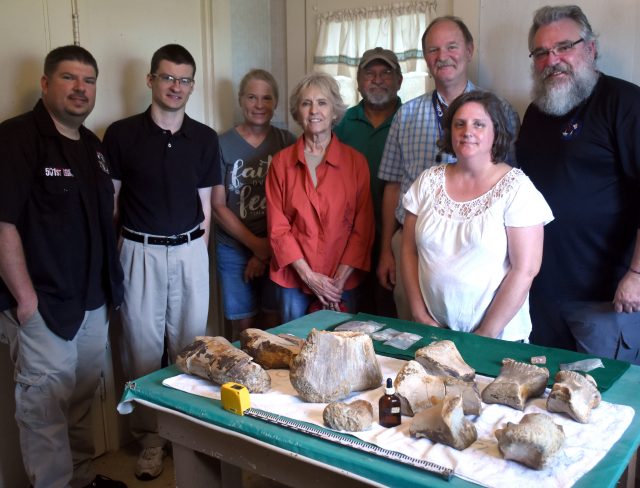
By John R. Schirmer
News-Leader staff
Three representatives of the Arkansas Geological Survey were in Nashville July 5 for a first-hand look at dinosaur bones donated earlier this year to the Howard County Historical Society.
“I called them to help with the arrangement of the bones,” society president Freddie Horne said.
The three included Angela Chandler, Doug Hanson and Corbin Cannon.
They met with Horne and other members of the local history organization to offer suggestions and help the group to plan future displays of the bones.
The visitors “are geologists, not paleontologists,” Horne said. “They study the minerals and bone compounds in the environment that caused them to be mineralized.”
Paleontologists “recognize the shape, size and color of the bones and how they relate to the animal,” in this case a hadrosaur, Horne said.
The geologists try to determine where the bones came from based on a chemical test, color and the soil stratum, according to Horne. They look at the material on the pieces and at the end of a piece. “They can determine a lot about a bone from what’s in the center, like the rings of a tree.”
The whole process “is like a jigsaw puzzle to put together,” Horne said.
The geologists and historical society are trying to determine where the hadrosaur originated and say there is the possibility that the creature could have come from what is now Oklahoma. “That’s based on the color,” Horne said. “The geologist says, ‘Let’s find dirt like the bones and see where they’re from.’ That’s the piece of the puzzle now, to match the stratum of the fossil to a location in Arkansas. They want to know where it came from.”
The historical society will contact the family which donated the bones to decide
“the exact location” of their origin.
Horne said the organization plans to display the bones, possibly on a temporary basis with a rotation for special occasions. That decision will be up to the museum board, he said.
“Instead of a permanent display, we may have the rotating schedule. “I’m ready to have them on display,” Horne said, possibly by the time school starts in August or shortly thereafter.
“We want science classes to come look at them. We’ll be able to let colleges take a look by appointment. We’ll make them available to science students in geology and paleontology throughout the state.”
The geologists and local historical society members wear bones when handling the bones to prevent oil from their hands from building up. The bones “don’t have to have a controlled environment. They don’t need a particular climate,” Horne said.
While in Nashville, the geologists “studied the pieces and did a chemical test. I thank Scott [Horne] and the chemistry department at Nashville High School for helping with the chemical test.”
Horne has been using charts from the Smithsonian Institution to help identify the different pieces. The animal was “a duck-billed dinosaur. There are 8-10 different kinds of hadrosaurs all in that family. They lived in Canada, in the northern part [of what is now the United States], and in the southern U.S.”
Working on the dinosaur project “has been a neat experience,” Horne said. “I’m totally proud of the [bone] collection and want people to see them.”







